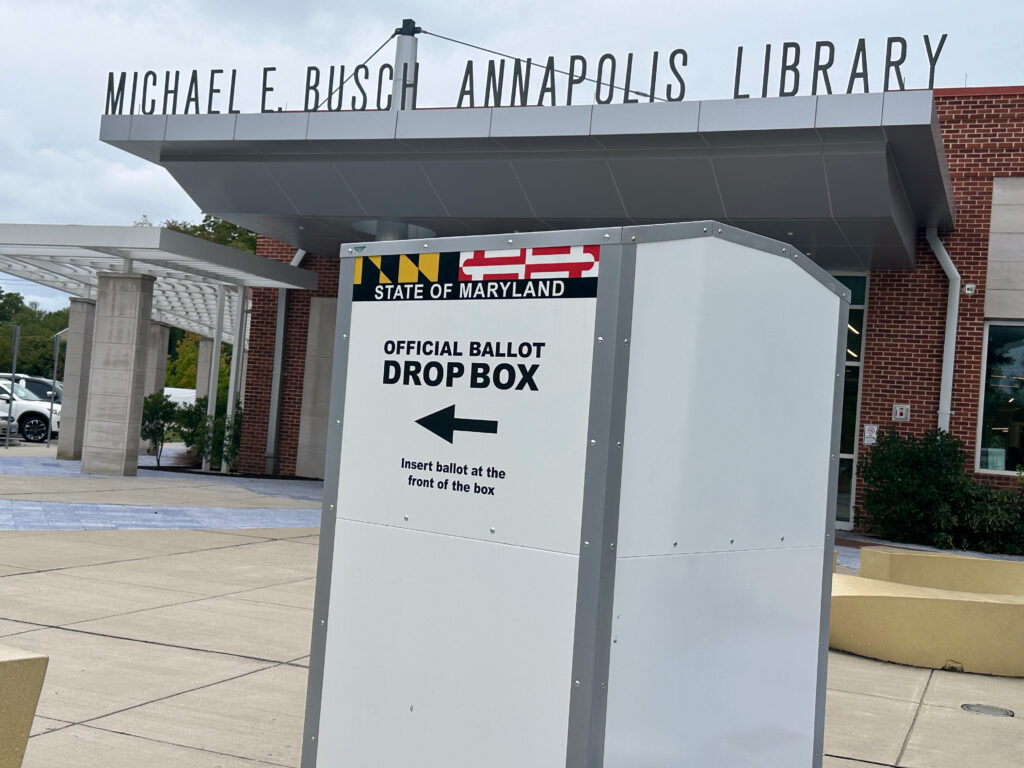
This ballot drop box outside the Michael E. Busch branch of the Anne Arundel County Public Library is one of 280 around the state. Photo by Bryan P. Sears.
Maryland’s top election official said voters can be confident in the security of the state’s mail-in voting system, brushing back issues raised over the weekend by state Republican Party officials.
The party statement Sunday followed an incident last week when an official with the Carroll County Republican Central Committee tailed the county’s election director, as she picked up ballots from a drop box and drove them back to the county election board offices.
The state party letter demanded that state election officials change their chain-of-custody rules to follow a set of national best practices for collection of ballots from the state’s 280 drop boxes.
State Election Administrator Jared DeMarinis said the 24 local boards of election already follow those guidelines, but that there is flexibility for smaller jurisdictions.
“Transportation of mail-in ballots is handled by professionals whether it’s postal workers, election directors, or election staff,” DeMarinis said. “Voters can feel confident in the transportation of those ballots back to the office under the chain-of-custody policies and procedures of the state board elections.”
That same Carroll County election official who was taileed sought a peace order against the county central committee who followed her from the ballot box location to the election board offices.
State Republicans said the Carroll County incident last week highlighted “potential risks of insufficient chain of custody protections over mail-in ballots.”
“There are serious security and integrity concerns associated with having an individual election worker transport ballots in their personal vehicle,” the Republicans said in a statement. “As such, the Maryland Republican Party is calling on the State Board of Elections to make changes to their ballot drop box transportation practices.”
Republicans called for the state and local boards “immediately alter their policies on ballot transportation to comply with these EAC (Election Assistance Commission) best practices and require that all ballots retrieved from drop boxes be monitored and transported by bipartisan teams of election workers or poll watchers.”
“It is critical that Marylanders have full confidence in the accuracy of the November 5th election results, and the integrity of our voting system in 2024 and beyond,” Republican Party Chairwoman Nicole Beus Harris said in the statement. “Accountability and scrutiny from bipartisan teams of poll watchers or workers must be present wherever it is feasible. These practices must be changed, immediately, to ensure a proper chain of custody and enhanced integrity at our state’s ballot drop boxes.”
The EAC, in a seven-page white paper, recommends the use of bipartisan teams to pick up ballots deposited in drop box. But the best practices also include language suggesting that election officials may also transport the ballots.
“Each county has different challenges. The collection of ballots has to be reflective of the county environment,” DeMarinis said. “We have county offices where the staff is three. You have others where there’s 60 or 70 people. You have to be flexible to the extent practicable for the collection.”
As of Monday, more than 300,000 ballots from around the state had been returned using the U.S. Postal Service. Another 287,000 were returned using the 280 drop boxes around the state, according to DeMarinis.
For more than a month, election officials have been receiving ballots by mail or collecting them from drop boxes. To be counted, mail-in ballots must be postmarked by Nov. 5 or dropped in a drop box by 8 p.m. that same day. Any ballot returned by mail must be received in the elections office by 10 a.m. Nov. 15 to be counted.
DeMarinis said there are chain-of-custody procedures governing ballots that are “traceable and auditable.” Additionally, each party is given a list of ballot requests made by voters. Those lists are used during ballot canvassing where watchers from each party can challenge a ballot if there is a question, said DeMarinis.
“The entire process is open and transparent,” he said. “Watchers, observers and challengers have always had access to where votes and voting has occurred. They’re at polling places. They’re at early voting centers. They’re at the canvas. Additionally, the board of canvassers is made up of representatives from those political parties.
“You have all these checks and balances in the system to make sure that it is safe and secure and that it is an accurate reflection of Maryland’s will,” DeMarinis said.

